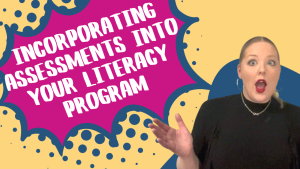Assessing students’ literacy skills is pivotal for understanding their progress and refining teaching methods tailored to their needs. This post breaks down the three primary types of literacy assessments and explains how you can effectively incorporate them into your teaching strategy.

Diagnostic Assessment: The Starting Point
Diagnostic assessments provide an initial insight into where your students stand in terms of their literacy capabilities. The purpose of this literacy assessment is to determine students’ strengths, weaknesses, and baseline skills at the beginning of each term.
Examples of Literacy Assessments:
-
- Standardized tools like DRA or CASI, particularly beneficial for junior grade teachers.
- DIBELs for assessing oral language fluency and comprehension.
- Nonsense word lists to test phonics knowledge and decoding skills, spotlighting issues with word memorization or whole-word reading.
- Spelling diagnostics such as the ones within “Words Their Way.”
For assessing writing, an informal approach works best. Simply request students to draft a recount, story, or paragraph. This will help gauge their word choice, vocabulary, spelling, and more.
Formative Assessment: The Weekly Check-in
Formative assessment is the continuous process of gathering data on student learning. The purpose of this literacy assessment is to observe and record students’ progress as they grasp different skills weekly.
Examples of Literacy Assessments:
-
- Observations of students working in groups.
- Collection and marking of work samples.
- Exit cards to quickly understand lesson comprehension.
- Student-teacher conferences for in-depth discussions about their learning journey.
Remember, the goal isn’t to grade but to understand their mastery over concepts. Additionally, using tools like a literacy tracker can help streamline this process, ensuring you have a comprehensive view of each student’s progress.
Summative Assessment: The Term Review
Summative assessments provide an overarching view of students’ proficiency levels. The purpose of this literacy assessment is to offer a holistic view of students’ skills and determine their readiness to progress.
Examples of Literacy Assessments:
-
- Revisiting formative assessments, such as reading responses or writing tasks, as part of the summative evaluation.
- Asking students to choose, refine, and submit a piece of work they’re proud of.
- Incorporating exit cards or snapshots of students’ work throughout the term.
These assessments should highlight students’ overall proficiency, understanding, and growth.
Conclusion
Assessment in literacy is a multi-faceted process encompassing diagnostic, formative, and summative evaluations. By judiciously using a mix of these tools and methods, educators can derive invaluable insights into their students’ literacy progress, enabling them to modify their teaching techniques to best suit individual student needs. Always remember, the goal is not just to grade but to understand, support, and elevate every student’s literacy journey.
Watch It On YouTube
Listen To The Podcast
Still need more help with assessing students?
Check out these blog posts:
ASSESSMENT AND THE TRIANGULATION OF DATA






